VI65 text editor
A VI implementation for 6502 machines.
This is the "manual" of the multi platform VI65 0.2 editor.
The editor (and the documentation) is far from finished, and there are
a lots of bugs. Maybe the next version will be better ;)
Supported platforms:
Commodore 64, 128, 16, Plus 4, VIC20 (expanded), PET 40/80.
Atari 8bit, Apple II.
There's a plugin version for the IDE64 filemanager too.
Supported text modes:
- C64 - 40/53/64/80x25 (VDC 80x25 on C128)
- C128 - 40/53/64/80x25, VDC 80x25
- +4 - 40x25, 53/64/80x23
- C16 - 40x25
- VIC20 - 22x23, 26/35/40x22
- PET - 40/80x25
- ATARI - 40/53/64/80x24
- APPLE II - 40/46/56/80x24
Some text modes use custom 4x8, 5x8 and 6x8 charsets on graphic screen.
Screenshots:
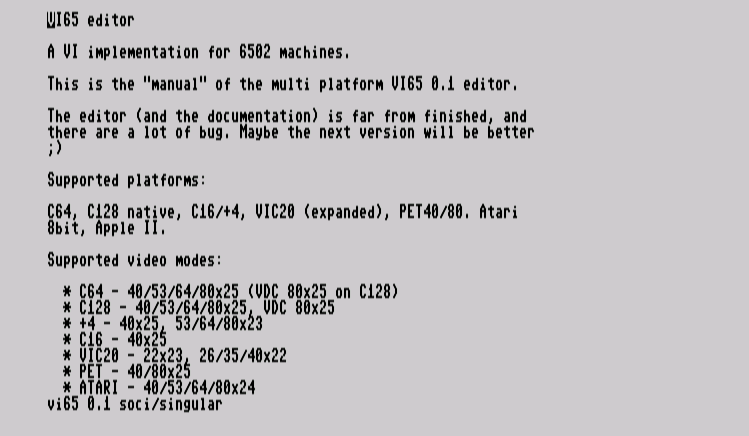

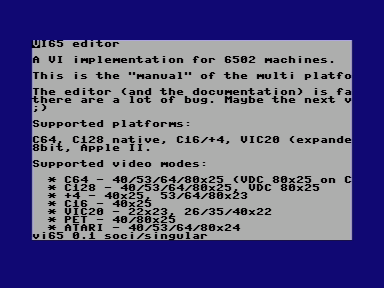
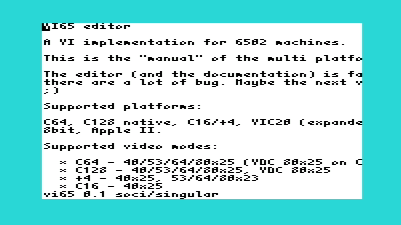

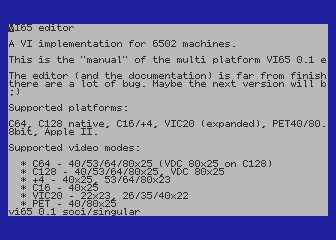

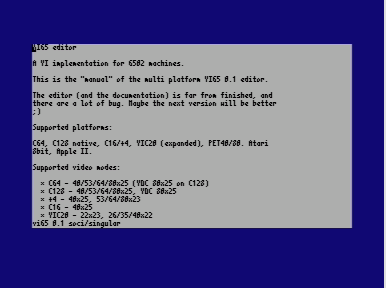
Limitations:
- 251 characters in a line
- 65535 lines of text (memory runs out faster...)
- 65535 maximum count
- Platform native text format only
- Paste register only limited by the amount of memory
- No extra memory support yet
- Single buffer editing for now
The following key description was mostly copied from the
VIM 7.2 manual.
Motion keys
j or <Right>
[count] characters to the right. exclusive motion.
h or <Left> or CTRL-H
[count] characters to the left. exclusive motion.
0 or <Home>
To the first character of the line. exclusive
motion.
g$ or g<End>
To the rightmost
character of the current line that is visible on the
screen. Differs from "$" when the last character of
the line is not on the screen.
Additionally, vertical movements keep the column,
instead of going to the end of the line. inclusive.
g0 or g<Home>
To the leftmost
character of the current line that is on the screen.
Differs from "0" when the first character of the line
is not on the screen. exclusive motion.
gm
Like "g0", but half a screenwidth to the right (or as
much as possible). exclusive.
^
To the first non-blank character of the line. exclusive.
|
To screen column [count] in the current line.
exclusive motion.
$ or <End>
To the end of the line. When a count is given also go
[count - 1] lines downward inclusive.
t{char}
Till before [count]'th occurrence of {char} to the
right. The cursor is placed on the character left of
{char}. inclusive.
f{char}
To [count]'th occurrence of {char} to the right. The
cursor is placed on {char}. inclusive.
T
Till after [count]'th occurrence of {char} to the
left. The cursor is placed on the character right of
{char} exclusive.
F
To the [count]'th occurrence of {char} to the left.
The cursor is placed on {char} exclusive.
L
To line [count] from bottom of window (default: Last
line on the window) on the first non-blank character
linewise.
H
To line [count] from top (Home) of window (default:
first line on the window) on the first non-blank
character linewise.
M
To Middle line of window, on the first non-blank
character linewise.
G
Goto line [count], default last line, on the first
non-blank character linewise.
gg
Goto line [count], default first line, on the first
non-blank character linewise.
j or <Down> or CTRL-J or CTRL-N or <NL>
[count] lines downward linewise.
k or <Up> or CTRL-P
[count] lines upward linewise.
- <minus>
[count] lines upward, on the first non-blank
character linewise.
+ or CTRL-M or <CR>
[count] lines downward, on the first non-blank
character linewise.
'{a-z}
The cursor is positioned on the first non-blank
character in the line of the specified location and
the motion is linewise.
`{a-z[]} or <-{a-z[]}
The cursor is positioned at the specified location
and the motion is exclusive.
Normal mode keys
gI
Insert text in column 1.
c{motion}
Delete {motion} text and start
insert.
C
Delete from the cursor position to the end of the
line and [count]-1 more lines , and
start insert. Synonym for c$
s
Delete [count] characters and start
insert (s stands for Substitute). Synonym for "cl"
S
Delete [count] lines and start
insert. Synonym for "cc" linewise.
y{motion}
Yank {motion} text .
d{motion}
Delete text that {motion} moves over .
D
Delete the characters under the cursor until the end
of the line and [count]-1 more lines synonym for "d$".
x
Delete [count] characters under and after the cursor
(not linewise). Does the same as
"dl".
X
Delete [count] characters before the cursor (not linewise). Does the same as "dh".
O
Begin a new line above the cursor and insert text
o
Begin a new line below the cursor and insert text
p
Put the text after the cursor
[count] times.
P
Put the text before the cursor
[count] times.
J
Join 2 lines.
m{a-z}
Set mark {a-z} at cursor position
<backspace>
Move backward.
<space>
Move forward.
zL
Move the view on the text half a screenwidth to the
right, thus scroll the text half a screenwidth to the
left.
z<Right> or zl
Move the view on the text [count] characters to the
right, thus scroll the text [count] characters to the
left.
zH
Move the view on the text half a screenwidth to the
left, thus scroll the text half a screenwidth to the
right.
z<Left> or zh
Move the view on the text [count] characters to the
left, thus scroll the text [count] characters to the
right.
ze
Scroll the text horizontally to position the cursor
at the end (right side) of the screen.
zs
Scroll the text horizontally to position the cursor
at the start (left side) of the screen.
CTRL-E
Scroll window [count] lines downwards in the buffer.
CTRL-Y
Scroll window [count] lines upwards in the buffer.
A
Append text at the end of the line.
a
Append text after the cursor times. If the
cursor is in the first column of an empty line Insert
starts there.
I
Insert text before the first non-blank in the line
/
Search for text.
:q
Quit. No question for unsaved changes yet!
:f [filename]
Set/print filename
:e [filename]
Edit file. File is loaded in the background,
the loaded part can be edited imediately.
Paste register is not cleared!
:w [filename]
Write file.
Download
VI65 v0.1
VI65 v0.2
That's all for now.
VI65 (C) 2010-2011 Soci/Singular <soci at server c64.rulez.org>







